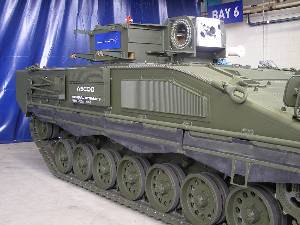Articles >>
GD Scout SV Begins to Take Shape With Joining of Turret to Test Base Unit
Category: Defence Industry

London, United Kingdom -- Little over a year since signing the Specialist Vehicle (SV) contract between the UK Ministry of Defence and General Dynamics UK, the first test version of the reconnaissance variant, Scout, has begun to take shape with the successful joining of the Experimental Demonstration Unit (EDU) turret to a "mule" base platform at the first attempt. The first successful combining of turret and base unit last week further proves the vehicle design, the systems integration between the two sections and the team work between prime contractor General Dynamics UK and turret design authority Lockheed Martin UK. It also highlights the excellent progress achieved by the Scout SV Industry team at an early stage. "Mating the turret and base unit at such an early stage of the demonstration phase once again demonstrates our dedication to working towards delivering the Scout SV capability to the British Army as soon as is possible," commented Dr. Sandy Wilson, president and managing director of General Dynamics UK on witnessing the event. "The fact that it happened at the first attempt only goes to show that the MoD chose the right team to deliver Scout SV." The key advantages that the Scout SV will deliver to the British Army will include:
The innovation of a 1.7 meter turret ring means that the Scout turret is designed to optimise fightability by maximising space for the soldiers inside. This gives soldiers considerable room for modern display screens, comfort for long periods inside the turret and ease of movement, even while wearing full body armour. With the need for military electronics ever-expanding on operations, the open electronic architecture allows significant growth for upgrades. The mule base unit, known as PT3, is based on a mature ASCOD vehicle already in service with the Austrian Army. The 1.7 metre race ring, specifically designed by General Dynamics UK for Scout, was integrated onto the vehicle by General Dynamics European Land Systems at its Simmering facility in Austria. The vehicle was then transported to General Dynamics UK's Pershore facility in Worcestershire, UK, to undergo a series of tests and prepare it to accept the EDU turret. It was then transferred to Lockheed Martin UK's facility in Ampthill, Bedfordshire last week for the integration of the turret. In parallel, the first EDU turret was being built at Rheinmetall Landsysteme in Gersthofen, Germany. Rheinmetall Landsysteme designs, develops and manufactures the Scout SV Turret Structure for turret design authority Lockheed Martin UK. Following a successful first build of the turret, the mandated CT40 Cased Telescoped Cannon System was integrated into it and fired for the first time in May, five months ahead of schedule. It was also subsequently transported to Ampthill where it has been undergoing extensive testing and preparation for integration with the PT3 mule base unit. British troops using the Scout SV will have the best protection available in this vehicle class, both as it is delivered and as it grows to meet future threats. The vehicle will be immediately capable of delivering load-carrying growth potential of up to 42 tonnes thanks to a modern, proven drivetrain. This means that SV is capable of being equipped to meet future threats likely to appear over its entire 30 year life, without the need to upgrade its engine or transmission during that time. |
GDLS |
TEMPORARY COMPANY GROUPING EBMR MEETS ITS DELIVERY OBJECTIVES FOR 2019
14.01.2020
General Dynamics UK selected for Army Warfighting Experiment 2019
23.09.2019
THALES AUSTRALIA AND GENERAL DYNAMICS ORDNANCE AND TACTICAL SYSTEMS DELIVERING FOR THE ADF
12.06.2019
Thales Raytheon Systems France
Thales Optronics (Taunton) Ltd
Thales Training & Simulation (USA)
SCOUT SV Ajax (Infantry fighting vehicle)
Discuss
